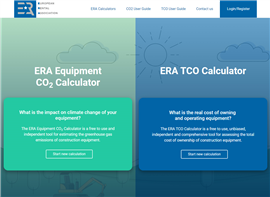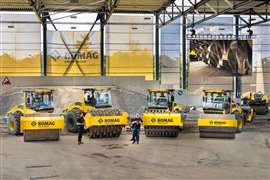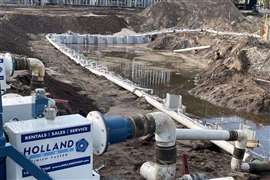Read this article in French German Italian Portuguese Spanish
First look: Hyundai’s new HX19e electric mini excavator
01 July 2025
IRN reports on Hyundai’s first battery powered mini excavator, which the OEM says is anything but a ‘me too’ machine.
The idea of a battery electric mini excavator is no longer a novel concept. A growing number of manufacturers have at least one electric mini as part of their compact machinery line-up, offering rental companies a viable alternative to diesel power, for those markets keen to reduce their carbon footprint.
Hyundai Construction Equipment may have come slightly late to this particular party, with so many competitors already trying to attract the, as yet relatively few buyers in this sector. Yet, the South Korean company is saying it hasn’t just arrived with a me-too machine, but has looked at what others have done and attempted to move the market on.
One of the limiting factors for many early electric minis has been potential running time. Between 4-6 hours of continuous use seems to be the norm, with manufacturers claiming that few typical mini excavator customers will operate a machine intensively throughout a full eight-hour shift.
Battery power
Hyundai has been happy to join this group, offering its new HX19e mini with a 32kWh battery pack that can deliver over five hours of working time. However, the company is also offering the machine with an alternative 40kWh battery pack, that it claims can deliver up to 10 hours of typical mini excavator use. That should see most customers through the working day with ease.
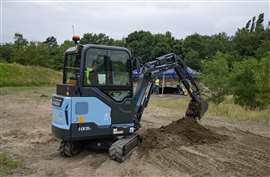 Hyundai’s new HX19e battery powered mini excavator. (Photo: Hyundai)
Hyundai’s new HX19e battery powered mini excavator. (Photo: Hyundai)
Either battery drives the same 13kW electric motor, replacing the traditional HX19A’s 12.1kW diesel engine. This similar level of output means that the machine can offer competitive performance, with the same 16kN bucket breakout force and a slightly higher 9.4kN dipper arm breakout force, when compared to the diesel model.
Apart from the powertrain and a dedicated monitor in the cab, the machine uses standard HX19A bodywork and digging equipment, including a 1.75m boom and a 1.03m dipper arm. That gives the HX19e a maximum digging depth of 2,340mm and a forward reach of 3,940mm.
The excavator sits on hydraulically extendable track frames, providing a minimum width of 994mm when retracted, for easy access to confined working areas, extending to 1,290mm for maximum stability when working. Two-speed tracking offers a maximum travel speed of 3.7km/h, though extended tracking will consume battery power faster than digging or lifting.
Environmentally-friendly
Sensing that some customers may opt for electric drive to allow use in environmentally-sensitive areas, Hyundai has equipped the HX19e with biodegradable Panolin VG46 hydraulic oil as standard, removing any risk of contamination from attachment changes or spills. As the machine does without engine oil, or any need for fuel, oil or air filters, the hydraulic circuit is one of the few areas that will require regular service and maintenance, cutting overall running costs for customers.
Indeed, buyers of the electric mini have few decisions to make, with the only options being cab or canopy, 32kWh or 40kWh battery. Everything else, including hose burst safety valves on the main boom, dipper arm and dozer blade hydraulic cylinders, is standard. The machine also comes with two-way auxiliary piping, for use with a range of attachments and LED booms lights.
As mentioned, you can have the HX19e with a cab or a canopy and in either case operators get a mechanical suspension seat and an MP3 compatible radio with USB connectivity. Access to the operator’s seat is fairly tight for larger frames, but once in position the HX19e provides a comfortable working environment, with decent visibility all round.
Having turned on the ignition switch, the operator has to press a secondary safety button in the right-hand lever head, before lowering the hydraulic cut-out on the left-hand lever pod to bring the hydraulics into play. This is all explained on the new touchscreen to the right of the cab.
There is a rotary ‘throttle’ dial to the left of the driver, although nothing actually happens until the levers are used. This is of course the secondary benefit of an electric machine. Not only are there no exhaust emissions, but there is also very little noise, other than a warning sound to let others know when the excavator is tracking. Plus, there is no ‘ticking over’ so operators won’t be using fuel unnecessarily.
Productive mini
The HX19e has plenty of digging power, breaking through compacted soils with ease. The machine is smooth in operation and it is easy to multi-function the levers to grade and finish cut a trench excavation. Indeed, in operation, other than the lack of noise and exhaust emissions, there is little difference between the diesel and electric models.
Which, to some extent, is the idea of course. Getting companies to accept an electric machine is hard enough, having to alter the way that they work with that machine would be counter-productive.
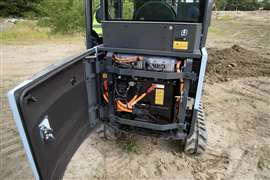 The HX19e comes with a 32kWh battery pack but is also available with a 40kWh pack. (Photo: Hyundai)
The HX19e comes with a 32kWh battery pack but is also available with a 40kWh pack. (Photo: Hyundai)
The mini excavator is equipped with a Type 2 automotive charger, allowing users to charge from a car charging point or, with an adapter, from a standard domestic 230/240V outlet. This should make charging easier on construction sites, or for rental customers using the HX19e in a domestic situation.
There is also a REMA DIN 320 input that allows rapid DC charging, when suitable electrical supplies are available. While the AC charger will take 4.8 hours for the smaller 32kWh battery and up to 6 hours for the larger 40kWh battery, the rapid charging circuit can be used to top-up the batteries in just 2 and 2.5 hours respectively.
Though using the HX19e designation, the compact machine can have an operating weight of up to 2,296kg, when equipped with a cab and the larger battery. That still allows towing to site on a 3.5-tonne trailer behind a van or pick-up, which will be an essential requirement for utilities and some rental businesses.
Future direction
Of course, the big question for all manufacturers, is who will buy an electric mini excavator? Mass demand has not yet really taken off. Initial interest has centred on the zero-emission aspect of the battery-powered machines, with demolition inside buildings and tunnelling operations making the machines an obvious choice. In both cases, exhaust fumes can cause operating issues and require expensive extraction equipment, that can be avoided by battery power.
There will also be a growing number of contracting customers that either want to be seen to be reducing their carbon footprint, or are working for clients that insist on low, or zero-emission machinery as part of their tender requirements, particularly local government clients. Being able to comply with this demand for clean operations, without sacrificing any of the performance and productivity of a diesel-powered excavator, may be enough to sway an increasing number of operators.
There must also be an opportunity for those rental companies working with the non-professional weekend domestic market. Few home users will have the facility to refill a diesel machine’s fuel tanks while remodelling their garden or digging footings for an extension. They will all have an electrical power outlet however.
There is a cost implication with electric machines, at least at the point of purchase. But things can look a lot more favourable when taken as part of a total cost of ownership calculation, with reduced service bills and operating costs factored in, depending on where you source your electricity. As we are seeing in the automotive market, price parity between fossil fuel and battery electric machines is getting closer, particularly in used markets and leasing costs in particular can be surprisingly low for some electric models.
The HX19e is Hyundai’s first all-electric mini excavator, but it will surely not be the last. With a range of more than a dozen compact machines, we can expect to see additional electric models coming to the market soon. Indeed, this transition is unlikely to be limited to compact sectors. Though demonstrating its investment in the hydrogen-powered market at the recent Bauma exhibition, with the HW155H wheeled excavator, the company also had a 23-tonne battery electric concept on show. The electric revolution continues.
STAY CONNECTED



Receive the information you need when you need it through our world-leading magazines, newsletters and daily briefings.
CONNECT WITH THE TEAM








